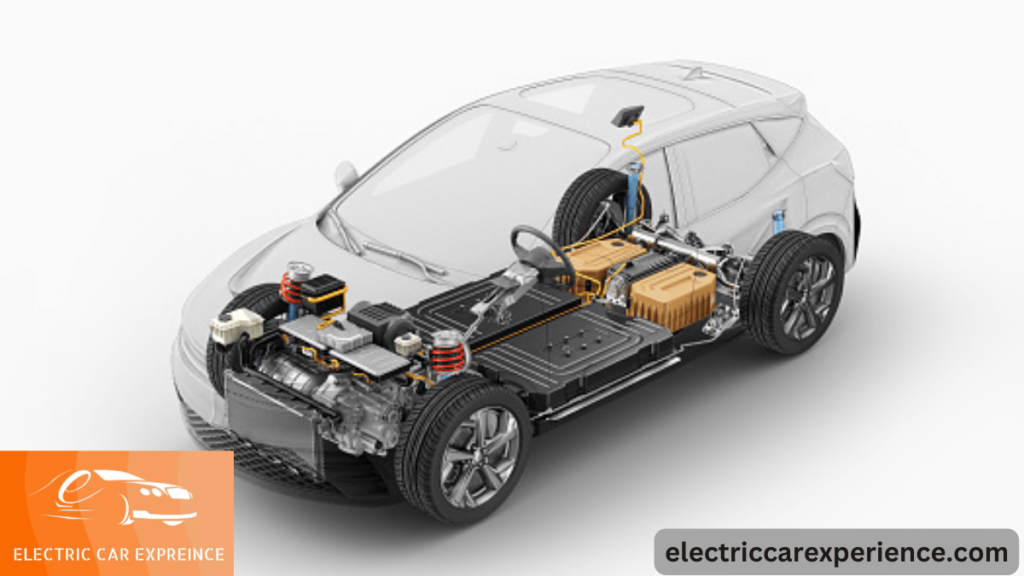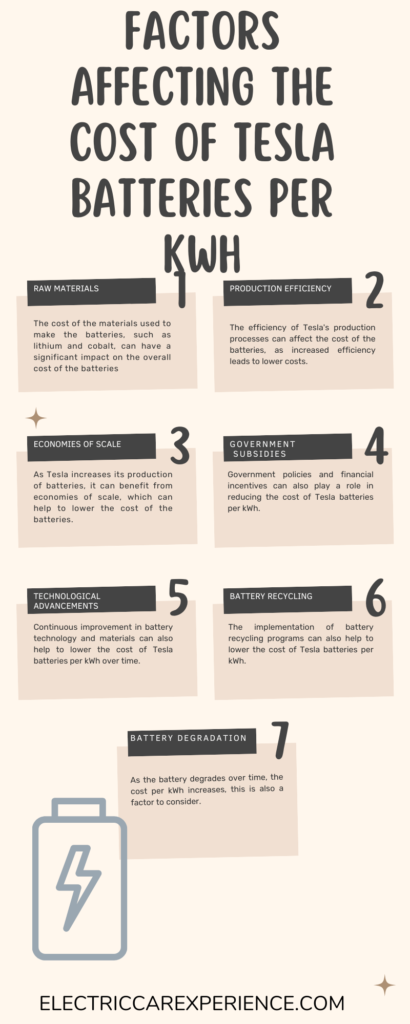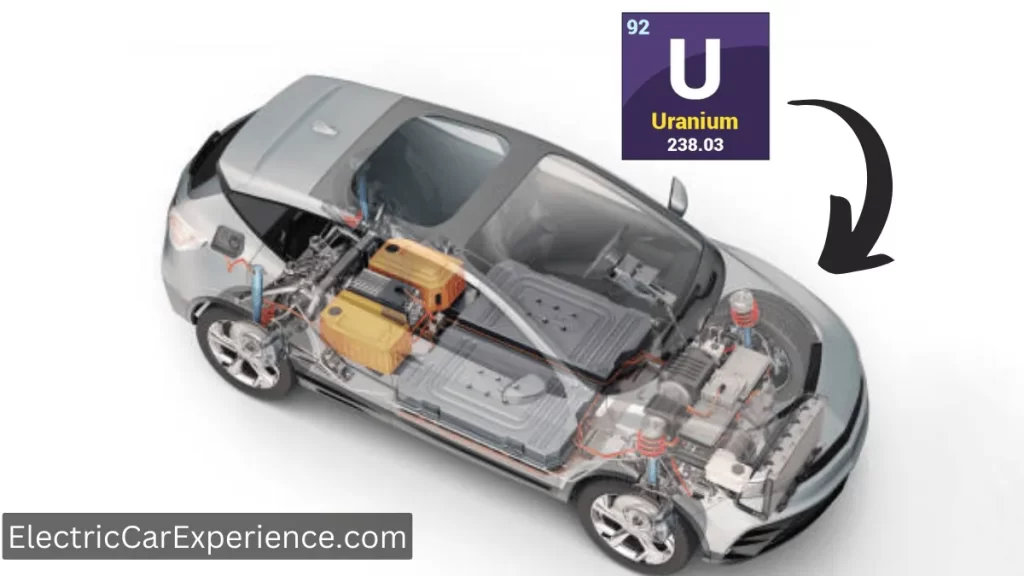
The cost of Tesla batteries per kilowatt-hour (kWh) has been a topic of much interest in recent years, as it is a crucial factor in determining the overall cost of electric vehicles and their competitiveness with traditional gasoline-powered cars. Then how much does Tesla cost per kWh?
Factors that affect the cost of Tesla battery Cost per kWh include the cost of raw materials, production efficiencies, and economies of scale. Tesla’s economies of scale, thanks to its Gigafactories, have helped to significantly lower the cost of its batteries. Additionally, government subsidies and incentives can also play a role in reducing the Tesla battery cast per kWh. The standard cost for the replacement of a Tesla battery is between $13,000 and $14,000. The new Tesla battery for the high-end Model S vehicle generally costs between $13,000 and $20,000.
The actual cost of batteries, the key-making block of electric vehicles, has also declined in these recent years. Per Kwh, this electric vehicle industry’s average battery costs have also declined from an average of around $384 per kilowatt-hour (KWh) in 2015 to near about $137 per kWh.
Given its greater volumes, superior negotiating position with suppliers, and different battery cells and architecture, Tesla continues to lead the Electric car sector in terms of cost.
It is safe to conclude that its battery prices are 20% cheaper than the market average. Prices of around $110 per kWh of capacity would result from this.
[toc]
According to the assumption that the typical Tesla battery has a capacity of around 70 kWh, the cost of a battery for a single vehicle is estimated to be $7,700, down from about $21,000 in 2015. This has contributed to Tesla’s gross margins rising to about 26% in 2020.
Technological advancements and battery recycling also have the potential to lower the cost of Tesla batteries per kWh in the future.
Let’s Talk about Tesla Battery Cost Per kWh

The SUV of Tesla utilizes the falcon wing doors for passenger access. The model’s battery was available in 4 various lithium-ion battery packs, which differed in the battery capacity.
However, Tesla no longer makes the first three packs as mentioned above, thus, currently, only the 100 kWh model is available for purchase. Of course, the weights of these four bundles varied: 60 kWh weighed 848 lbs (385 kg), 75 kWh weighed 1168 lbs (530 [), 90 kWh weighed 1250 lbs (567 kg), and 100 kWh weighed 1377 lbs (625 kg).
| 60 kWh | 848lbs | 385 kg |
| 75 kWh | 1168 lbs | 530 kg |
| 90 kWh | 1250 lbs | 567 kg |
| 100 kWh | 1377 lbs | 625 kg |
The global supply of electric vehicles and the demand for their batteries are expanding as the cost of EV batteries continues to decline.
A lithium-ion (Li-ion) electric vehicle battery pack’s average cost has decreased from $1,200 per kilowatt-hour (kWh) in 2010 to just $132/kWh in 2021.
Several interconnected modules comprise tens to hundreds of rechargeable Li-ion cells inside each Electric car battery pack. These cells add up to about $101/kWh or about 77% of the average battery pack’s overall cost.
“replacing battery modules costs between $5,000 and $7,000. Each Tesla model uses between four and five battery modules per vehicle, meaning a complete replacement will set you back between $20,000 and $35,000.”
Elon Musk
So, what drives the actual cost of these specific individual battery cells?
How Much Does a Battery Cell Cost?
Data show that the cathode cost of each cell accounts for more than half of the total cost of the cell.
| Electric Car Battery Cell Component | % of Cell Cost |
|---|---|
| Cathode | 51% |
| Manufacturing and depreciation | 24% |
| Anode | 12% |
| Separator | 7% |
| Electrolyte | 4% |
| Housing and other materials | 3% |
How Much Does This Cost?
It can surprise potential Tesla owners, but these cars utilize a small amount of electricity despite these powerful features.
The average Tesla electric vehicle utilizes around 34kWh of electricity per hundred miles. That has 34,000kWh per 100,000 miles, or up to 170,000kWh throughout the vehicle’s lifespan.
Your Tesla only charges $13.96 based on the national average power price. Across all models, that works out to around $0.05 per mile.
Therefore, a full charge for a Tesla Model X runs roughly $18.30, and a Model S is just a little behind at $18.29. The Model 3 costs the least to charge ($9.62), and a full Model Y charge is $13.58.
The cost of charging for each Tesla model is shown below:
Check out our interactive analysis. For a thorough analysis of how Tesla’s battery costs affect its entire cost base, see A Closer Look at Tesla’s Battery Costs.
The battery makes up over half of the price of the Tesla, which is the cheapest at $46,990 before incentives. The U.S. National Highway Traffic Safety Administration and Euro NCAP awarded the Model S a 5-star safety rating in 2014. (NHTSA).
Factors Affecting the Cost of Tesla Batteries Per kWh.

Several factors play a role in determining the cost of Tesla batteries per kWh, including the cost of raw materials, production efficiency, economies of scale, government subsidies, technological advancements, and battery recycling.
Understanding these factors can provide insight into how the cost of Tesla batteries per kWh may change over time and how it compares to other Electric car manufacturers.
The cost of Tesla batteries per kilowatt-hour (kWh) is affected by a variety of factors. These include:
| Factor | Description |
|---|---|
| Raw materials | The cost of the materials used to make the batteries, such as lithium and cobalt, can have a significant impact on the overall cost of the batteries. |
| Production efficiency | The efficiency of Tesla’s production processes can affect the cost of the batteries, as increased efficiency leads to lower costs. |
| Economies of scale | As Tesla increases its production of batteries, it can benefit from economies of scale, which can help to lower the cost of the batteries. |
| Government subsidies | Government policies and financial incentives can also play a role in reducing the cost of Tesla batteries per kWh. |
| Technological advancements | Continuous improvement in battery technology and materials can also help to lower the cost of Tesla batteries per kWh over time. |
| Battery recycling | The implementation of battery recycling programs can also help to lower the cost of Tesla batteries per kWh. |
| Battery degradation | As the battery degrades over time, the cost per kWh increases, this is also a factor to consider. |
Comparison Of Tesla Battery Cost Per kWh To Other Electric Vehicle Manufacturers
Comparing the cost of Tesla batteries per kilowatt-hour (kWh) to other electric vehicle (Electric car) manufacturers can provide insight into how Tesla’s batteries compare in terms of cost.
However, it’s important to note that direct comparison can be difficult due to the different types of batteries and technologies used by different manufacturers, as well as variations in production efficiency and economies of scale.

Total Vehicle Cost
One way to compare the cost of Tesla batteries per kWh to other Electric car manufacturers is to look at the cost of the battery as a percentage of the total vehicle cost.
According to some estimates, the battery cost for Tesla vehicles can be as low as 15% to 20% of the total vehicle cost, which is lower than some other Electric car manufacturers.
Battery Pack
Another way to compare the cost of Tesla batteries per kWh is to look at the cost per kWh of the battery pack. This cost per kWh is lower than some other Electric car manufacturers, which can be around $150 per kWh.
According to some estimates, the cost per kWh of Tesla batteries has decreased significantly over the years, in 2019 it was around $137 per kWh, and in 2020 it was around $100 per kWh.
Cost Variation
It’s important to note that these comparisons are estimates and the cost of batteries varies depending on the technology, size, and other factors.
It’s also worth noting that Tesla is known for their vertical integration, which allows them to control the entire battery production process, from the mining of raw materials to the production of the final battery pack, and this can give them an advantage in terms of economies of scale.
Impact Of Economies of Scale on Tesla Battery Cost Per kWh

Economies of scale refer to the cost advantages a company can achieve by increasing its production of a particular product. In the case of Tesla, economies of scale can have a significant impact on the cost of its batteries per kilowatt-hour (kWh).
Reduction of Fixed Cost
One way that economies of scale can lower the cost of Tesla batteries per kWh is through the reduction of fixed costs.
As Tesla increases its production of batteries, the fixed costs of building and operating the Gigafactories can be spread over a larger number of batteries, resulting in a lower cost per battery.
Increase Battery Production
Additionally, as Tesla increases its production of batteries, it can negotiate better prices for raw materials such as lithium and cobalt, which can also help to lower the cost of its batteries per kWh.
Furthermore, by increasing the number of batteries produced, Tesla also benefits from the learning curve effect, where the company can improve its production processes and become more efficient over time.
This can help to lower the cost per battery, and thus the cost per kWh.
Finally, by increasing the volume of batteries produced, Tesla can also achieve greater economies of scale in the delivery and logistics of the batteries, which can help to lower the cost of batteries per kWh.
Role Of Government Subsidies and Incentives in Reducing Tesla Battery Cost Per kWh
Government Subsidies and Incentives
Government subsidies and incentives can play a role in reducing the cost of Tesla batteries per kilowatt-hour (kWh).
These subsidies and incentives can take various forms, such as direct financial assistance, tax breaks, or regulations that favor the production and use of electric vehicles (Electric cars) over traditional gasoline-powered vehicles.
For example, governments can provide direct financial assistance to Tesla to help with the costs of building and operating Gigafactories, which can help to lower the cost of Tesla batteries per kWh.
Tax Breaks
Another way governments can help to reduce the cost of Tesla batteries per kWh is through tax breaks for Electric car manufacturers and buyers.
For example, governments can provide tax credits for Electric car buyers which can help to make Electric cars more affordable, and this can help to lower the cost of Tesla batteries per kWh.
Regulations by Government
Governments can also set regulations that favor the production and use of Electric cars over traditional gasoline-powered vehicles, such as setting targets for Electric car adoption, mandating the use of Electric cars in public fleets, or providing charging infrastructure.
This can help create a market for Electric cars, which in turn can help to lower the cost of Tesla batteries per kWh.
Furthermore, Governments can also provide incentives for recycling and second-life use of Electric car batteries which can help to lower the cost of Tesla batteries per kWh.
Battery Recycling and Its Potential to Lower Tesla Battery Cost Per kWh
Battery recycling can have the potential to lower the cost of Tesla batteries per kilowatt-hour (kWh) by reducing the cost of raw materials and increasing the efficiency of battery production.
Reduce the Cost of Raw Materials
One way battery recycling can lower the cost of Tesla batteries per kWh is by reducing the need for mining and sourcing new raw materials, such as lithium and cobalt, which can be expensive and environmentally destructive.
Use Recycling Material to Produce New Batteries
Instead, recycled materials can be used to produce new batteries, which can help to lower the cost of Tesla batteries per kWh. Another way battery recycling can lower the cost of Tesla batteries per kWh is by increasing the efficiency of battery production.
Through recycling, manufacturers can reclaim valuable metals and chemicals from used batteries, which can be used to produce new batteries with a higher energy density, which can help to lower the cost of Tesla batteries per kWh.
Use of recycling Electric Car Battery
Furthermore, recycling can also help to reduce the environmental impact of Electric car batteries, by reducing the need for mining and sourcing new materials, and also by reducing the number of batteries that end up in landfills.
Finally, recycling can also help to increase the second-life use of Electric car batteries, which can help to lower the cost of Tesla batteries per kWh.
Technological Advancements and Their Potential to Lower Tesla Battery Cost Per kWh
Technological advancements have the potential to lower the cost of Tesla batteries per kilowatt-hour (kWh) by increasing the energy density of batteries and improving production processes.
Increase Energy Density of Batteries
One-way technological advancements can lower the cost of Tesla batteries per kWh is by increasing the energy density of batteries.
As the energy density of batteries increases, fewer batteries are needed to store the same amount of energy, which can help to lower the cost of Tesla batteries per kWh.
Improve Production Process
Another way technological advancements can lower the cost of Tesla batteries per kWh is by improving production processes.
For example, improvements in automation and robotics can help to increase production efficiency and reduce production costs, which can help to lower the cost of Tesla batteries per kWh.
Furthermore, advancements in battery chemistry and materials can also help to lower the cost of Tesla batteries per kWh. Finally, advancements in recycling processes can also help to lower the cost of Tesla batteries per kWh.
Improve the Efficiency of Battery Recycling
By improving the efficiency of battery recycling, manufacturers can reclaim more valuable metals and chemicals from used batteries, which can be used to produce new batteries, reducing the cost of raw materials and increasing the efficiency of battery production.
Cost Of Battery Replacement Over Time
For Tesla vehicles, the cost of battery replacement can depend on several factors, such as the age of the vehicle, the type of battery, and the extent of the damage to the battery.
In general, the cost of battery replacement for older Tesla vehicles can be higher due to the lower availability of replacement batteries and the cost of older battery technology.
As the number of Electric cars on the road increases, so does the demand for replacement batteries, which can drive up the cost of battery replacement over time.
Furthermore, advances in battery technology can also affect the cost of battery replacement over time. Another factor that can affect the cost of battery replacement is the availability of replacement batteries.
As new battery technology becomes available, older battery technology may become less expensive, making battery replacement more affordable for vehicle owners.
Effect Of Battery Degradation on Cost Per kWh Over Time
Battery degradation can affect the cost per kilowatt-hour (kWh) over time by reducing the overall energy capacity of the battery.
As the battery degrades, the amount of energy it can store and provide decreases, which can reduce the overall efficiency of the vehicle and increase the cost per kWh.
Temperature Affection
One factor that can affect the rate of battery degradation is temperature. Exposure to extreme temperatures, such as hot or cold temperatures, can accelerate battery degradation and reduce the overall lifespan of the battery.
Different Patterns of Vehicle
Another factor that can affect battery degradation is the usage pattern of the vehicle. Furthermore, battery degradation can also be affected by the battery management system (BMS) and charging processes.
An effective BMS can help to prolong the lifespan of the battery by monitoring and controlling the charging and discharging processes. Finally, the rate of battery degradation can also be affected by the quality of the battery and its components.
High-quality batteries and components can help to reduce the rate of battery degradation and prolong the lifespan of the battery, which can help to reduce the overall cost per kWh over time.
How Do Battery Costs Impact the Margins of Tesla?
Although battery costs are considered a major cost factor for electric vehicles, prices have been falling fast due to better technology and bigger volumes.
According to our calculations, the price of Tesla’s (NASDAQNDAQ +1.8%: TSLA) batteries has decreased from $230 per kilowatt-hour (kWh) in 2016 to $127 in 2019.
According to our estimations, battery costs have decreased from 19.4% to 15% of the average selling price of a Tesla vehicle during that time.
How much does maintaining a Tesla cost?
The average annual maintenance expense for a Tesla is $832, according to Repair Pal. In contrast, the average annual cost of all car models sold in the US is $652.
You can end yourself spending far more on annual maintenance than the average car owner, depending on the services your Tesla requires.
Tesla is still a relative newcomer to the automotive scene as of 2021. As a result, there is limited information available about Tesla’s general reliability and the average cost of ownership.
Further complicating issues is the fact that many of the components typically present in cars with internal combustion engines are absent from Tesla models.
How Tesla Replaces the Batteries of Your Vehicle?
There are various causes why the battery pack of Tesla will die. This could be the voltage regulator problem, the fuse problem, or another minor cause.
But the complete battery pack is generally affected if the issue is within one battery module. Even if only one module shows a value that is noticeably different from the rest, the complete pack could fail.
Once an old battery pack is fixed & checked, they also return that particular pack to the specific system, ready to be installed in another vehicle that requires the battery swap.
Tesla shops don’t swap out battery modules because they want to ensure the battery in your car is in perfect condition. Instead of simply swapping out one part of the battery, putting it back in your car, and calling it good, they have their technicians examine it in their facilities.
While this is a creature to use to guarantee that your automobile will be serviced and returned to nearly new condition, it is also pricey and can be beyond the means of some owners.
In early September 2019, the port Model Tesla Model S went quickly than an official record for the four-doors four-door electric s, ports car at lasts the previous time held by Tesla Model 3 performance.
| Configuration | Distance | Date |
|---|---|---|
| P100D | 670 mi (1,080 km) | August 5, 2017 |
| P100D | 560 miles (901.2 km) | June 20, 2017 |
| 85 kWh | 423.5 miles (681.6 km) | November 2012 |
Conclusion
Conclusion#1: Factors affecting Tesla Batteries cost per kWh
In conclusion, the cost of Tesla batteries per kilowatt-hour (kWh) is influenced by several factors, including economies of scale, government subsidies and incentives, battery recycling, technological advancements, and battery degradation.
The cost of battery replacement over time can also play a significant role in determining the cost per kWh.
Conclusion#2: Tips to Reduce Cost of Tesla Batteries per kWh
Advances in battery technology, the growth of the electric vehicle market, and the availability of government subsidies and incentives can all help to reduce the cost of Tesla batteries per kWh over time.
Proper battery management and the use of high-quality components can also help to reduce the impact of battery degradation on the cost per kWh.
Overall, the cost of Tesla batteries per kWh is an important consideration for both the company and its customers, and the continued growth and advancement of the electric vehicle market will likely have a significant impact on the cost of Tesla batteries over time.
Conclusion#3: Challenges for Manufacturers
The current increase in battery prices is a challenge for the profit margins of manufacturers of electric vehicles. Several people have a negative outlook on vehicle stocks because of rising pricing.
However, cost reduction involves more than just lowering commodity costs. That’s fantastic news for Tesla (ticker: TSLA) and all auto manufacturers fighting for a piece of the Electric car market that Tesla dominates.
FAQs
What factors affect the cost of a Tesla battery per kWh?
The cost of a Tesla battery per kWh can be affected by factors such as economies of scale, government subsidies and incentives, battery recycling, technological advancements, and battery degradation.
How do economies of scale affect the cost of a Tesla battery per kWh?
As the production of Tesla batteries increases, the cost per kWh can decrease due to the reduced costs associated with increased production efficiency and economies of scale.
Can government subsidies and incentives reduce the cost of a Tesla battery per kWh?
Yes, government subsidies and incentives can play a role in reducing the cost of a Tesla battery per kWh by providing financial support to the development and production of battery technology.
How does battery recycling impact the cost of a Tesla battery per kWh?
Battery recycling can help to reduce the cost of a Tesla battery per kWh by providing a source of recycled materials that can be used in the production of new batteries.
What role do technological advancements play in the cost of a Tesla battery per kWh?
Technological advancements in battery technology can help to reduce the cost of a Tesla battery per kWh by improving the efficiency and performance of batteries, leading to lower production costs.
How does battery degradation impact the cost of a Tesla battery per kWh over time?
Battery degradation can impact the cost of a Tesla battery per kWh over time by reducing the overall energy capacity of the battery, which can increase the cost of battery replacement and reduce the overall efficiency of the vehicle.
Post Related to Electric Car and Battery
- How Many Batteries In A Tesla Car (Model S, Model X, And Model Y) Complete Guide – 2024
- Do Tesla or Similar Electric Cars Have Battery-Saving Modes?
- How much is a battery replacement for an electric car in the US?- A complete guide 2024
- How Far Can You Drive a Tesla on 0 Battery
- Why BMW is choosing the path of Tesla for electric car?-An ultimate guide 2024
- What Are The Environmental Impacts of EV Battery?- An Ultimate guide 2024
- Tesla model range issues
- What Is The Horsepower Of The Tesla Cars (Model S, Model X, Model Y)
- Tesla Model S, Model X, Model Y, Model 3 EPA Range And Actual Range
- Tesla tire pressure not updating- Guide 2024
- Tesla Battery Replacement DIY (Do It Yourself)
- Can Tesla Increase Range With The Software Update?
- Tesla Battery Warranty (Model S, Model X, Model Y, Model 3, Extended Warranty) – Ultimate and Complete Guide 2024
